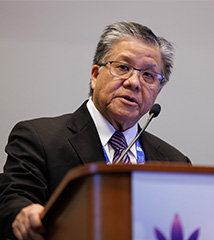

By Austin J. Sim, MD, JD, James Cancer Hospital – The Ohio State University

For decades, total body irradiation (TBI) has been mired in the archaisms of 2-D planning using an extended source to surface distance (SSD) technique. Lung blocks and, at times, kidney blocks, along with thickness measurements for compensation serve as rudimentary treatment planning. However, as the rest of radiation oncology has made technological leaps and bounds, TBI planning at many institutions remains relatively rudimentary. In pursuit of modernization, a number of institutions like City of Hope,1 Stanford2 and UT Southwestern,3 have adopted advanced planning techniques to further reduce organ at risk (OAR) doses. Jeffrey Wong, MD, Anthony Stein, MD, et al. take things a step further in this report of the results of their nonrandomized “Phase II Trial of Dose Escalated [Total Marrow and Lymphoid Irradiation] (TMLI) with Cyclophosphamide and Etoposide in Patients with Poor-Risk Acute Leukemia” as a conditioning regimen prior to allogeneic transplant.
In lieu of traditional 2-D techniques, investigators used IMRT/VMAT to selectively dose escalate the bone marrow, lymph nodes and spleen to 20 Gy while keeping the liver and brain to 12 Gy using a simultaneous integrated boost approach, 2 Gy twice a day on days -9 to -5. Etoposide 60 mg/kg was then given on day -4 and cyclophosphamide 100 mg/kg on day -2 prior to allogeneic transplant. Graft versus host disease prophylaxis was accomplished with tacrolimus and sirolimus. The primary endpoint of this study was progression free survival (PFS) and key secondary endpoints included overall survival (OS), non-relapse mortality (NRM) and toxicity.
This study enrolled a very high-risk cohort of 74 patients between 2014-2020, with the majority having AML (n=56, 76%) and the remainder having ALL. Despite 69% of patients having primary refractory disease after induction, 97% with detectable blasts in the marrow, and 49% with detectable peripheral blasts, the day +30 marrow CR rate was 92% and all patients were successfully engrafted. With a median follow-up of 1.8 years (4.2 years for surviving patients), the 2-year PFS and OS rates were 31.1% and 45.9%, respectively. NRM rates at day +100, year 1, and year 2 were 4.1%, 8.1% and 12%, respectively.
Compared to traditional planning techniques, investigators were able to achieve impressive OAR dose sparing with mean doses to the lung (8.8 Gy), kidneys (7.3 Gy), heart (7.5 Gy), thyroid (8.0 Gy), lens (2.5 Gy), and lower GI (10.2 Gy) significantly lower than the prescription dose with concomitantly low rates of toxicity. Not surprisingly, a level of peripheral blasts ≥20% were associated with a high risk of relapse or death.
At many institutions, TBI remains one of the last bastions of 2-D planning. However, with studies like this and newer cooperative group trials incorporating VMAT for TBI like COG ASCT2031,4 we are poised to emerge from the dark ages to join the rest of our field in the use of advanced planning techniques to widen the therapeutic ratio and strive to improve outcomes for high-risk patient populations. As the investigators note, this study has served as a springboard to bring TMLI in the management of more favorable patients, with a regimen of 20 Gy followed by post-transplant cyclophosphamide in patients with AML in CR1 in a follow-up study.
Abstract 253 - Phase II Trial of TMLI 20 Gy in Combination with Cyclophosphamide and Etoposide in Patients with Poor-Risk Acute Leukemia was presented during the SS 27 - Heme 1: Glowing Results: Clinical Trials of Radiation in Lymphoma session of ASTRO’s 66th Annual Meeting.